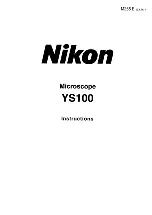
2. General safety instructions
Intended use: A non-medical device
This microscope is intended for general observation of cells and tissues, with transmitted/reflected illumination and
with the specimen fixed on a slide.
2.1 Dangers associated with the operation
•
Improper use could result in injury, malfunction or damage to property. It must be ensured that the operator
informs every user of existing hazards
•
Danger of electrocution. Disconnect the power to the entire lighting system before installing, adding or
changing any component
•
Not to be used in corrosive or explosive environments
•
Avoid direct exposure of eyes to the collimated light beam or direct light from the light guides or fibers
•
To avoid a hazard to children, account for all parts and keep all packing materials in a safe place
2.2 Photobiological safety LED, important safety instructions
•
Avoid direct eye exposure to any LED light source while switched on
•
Before looking through the eyepieces of the microscope, lower the intensity of the LED illumination
•
Avoid long and high-intensity exposure to LED light because this may cause acute damage to the retina of the eye
2.3 Prevention of biological and infectious hazards
Infectious, bacterial or viral biohazard substances under observation may be a risk to the health of humans and other
living organisms. Special precautions should be taken during in vitro medical procedures:
•
Biological hazards
: Keep a logbook of all the biological substances or pathogenic microorganisms that were
under observation with the microscope and show it to everybody before they use the microscope or before
they do some maintenance work on the microscope! Agents can be bacterial, spores, enveloped or non-
enveloped virus particles, fungi or protozoa
•
Contamination hazard:
•
A sample that is properly enclosed with a cover glass never comes in direct contact with the microscope
parts. In that case prevention of contamination lies in the handling of the slides; as long as the slides
are decontaminated before use and are undamaged and treated normally, there is virtually zero risk of
contamination
•
A sample that is mounted on a slide without cover glass, can come in contact with components of the
microscope and may be a hazard to humans and/or the environment. Therefore, check the microscope and
accessories on possible contaminations. Clean the microscope surfaces and its components as thoroughly
as possible. Should you identify a possible contamination, inform the local responsible person in your
organization
•
Microscope operators could be contaminated from other activities and cross-contaminate components
of the microscope. Therefore, check the microscope and accessories on possible contaminations. Clean
the microscope surfaces and its components as thoroughly as possible. Should you identify a possible
contamination, inform the local responsible person in your organization. it is recommended to wear sterile
gloves when preparing the slides and handling the microscope in order to reduce contamination by the
operator
•
Infection hazard:
Direct contact with the focusing knobs, stage adjustments, stage and eyepieces/tubes of
the microscope can be a potential source of bacterial and/or viral infections. The risk can be limited by using
personal eyeshades or eyepieces. You can also use personal protections such as operation gloves and/or safety
goggles, which should be changed frequently to minimize the risk
•
Disinfectant hazards:
Before cleaning or disinfecting, check if the room is adequately ventilated. If not, wear
respiratory protective gear. Exposure to chemicals and aerosols can harm human eyes, skin and respiratory
system. Do not inhale vapours. During disinfection, do not eat, drink or smoke. Used disinfectants must be
disposed of according to local or national regulations for health and safety
3






























